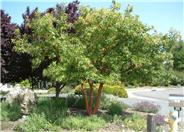
Common name:Strawberry Madrone
Botanical name:Arbutus 'Marina'
The 'Marina' has gorgeous bark, with leaves that are smaller and not as glossy as Pacific Madrone. Its flowers are pink, borne in pendant clusters in the summer. The fruit is large, red and quite ornamental. The plant should be grown in sun to part shade, with little or no summer watering when established. The 'Marina' prefers good drainage. -Monterey Bay Nursery
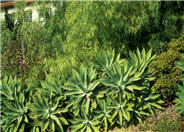
Common name:Fox Tail Agave, Velvet Agave
Botanical name:Agave attenuata
This Agave has a dramatic tropical form. Even light frost can damage its succulent leaves. It is great for containers. In the low desert, partial sun will be best. If it becomes top heavy, simply cut and stick in the ground to root. It is not a fast grower and has light green foliage. It will also die after flowering but pups around the mother will survive. Distinctive with its large rosette of leaves perched on a long curving trunk, it is a native from Mexico.
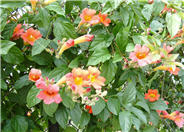
Common name:Scarlet Trumpet Vine
Botanical name:Distictis buccinatoria
This evergreen vine is highlighted by large, blood red, trumpet-shaped flowers with a yellow throat. These flowers will continue to appear throughout the warm months.
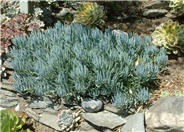
Common name:Kleinia
Botanical name:Senecio mandraliscae
This succulent perennial will grow to about 1.5' tall and 2' wide. It has curved, bluish gray leaves that are about 3.5" long and very slender.
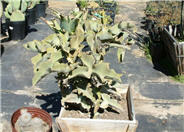
Common name:Felt Plant or Bush, Velvetleaf
Botanical name:Kalanchoe beharensis
This unusual succulent perennial will grow 4'-5' tall and wide. It has thick, fuzzy, gray green to golden leaves with inconspicuous flowers. Although tender to frost, it makes an excellent accent for rock gardens or desert themed landscapes.
| Designer: Los Angeles Arboretum | Outdoor Kitchen Area |
Photographer: GardenSoft |
Soils and Compost:
Incorporate compost 6" into your soil to retain water, reduce compaction, feed earthworms, and provide valuable nutrients to your plants.
Water Saving Tip:
Apply a layer of mulch around plants to reduce moisture loss.
Choose organic mulches, such as shredded bark, compost or aged sawdust.
Integrated Pest Management:
Attract, or buy beneficial insects such as ladybugs and lacewings to control pest outbreaks in your garden.

